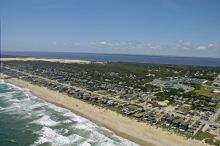
From oceanfront to soundfront and everything in between, the variety of properties available here can be overwhelming. This article will help buyers narrow down their search by describing features of several different Outer Banks locations.
In choosing a location for a beach home, buyers should determine their specific use. Buying a vacation rental property or second home is a little like purchasing a car or a boat — there are compromises a buyer must make regardless of the property. Each person should consider what factors are most important to him or her. For example, how important is a view? How important is beach access or access to goods and services. Fishermen may want to be closer to Oregon Inlet or Hatteras, and windsurfers may want to be closer to the Croatan Sound or the Haulover in Avon. The best rental home may not be the best second home or primary residence. Take time to write down those factors that you must have as well as those that definitely don’t want and share this information with your Realtor. This will save you a tremendous amount of time in your property search.
Below are a few different categories of property available on the Outer Banks and some of the pluses and minuses of each area.
Oceanfront
There is nothing like going to sleep listening to the waves wash up against this barrier island or watching the sun rise over the Atlantic, promising another day full of joy and fun. The beach and the ocean are why most people visit or live here, and every square foot of oceanfront is precious.
Somewhere around the beginning of the 20th century the first home was built along the oceanfront in Nags Head. People back then thought that the ones who chose to build there were crazy because they would be exposed to winter’s strong northeast winds and blowing sand. Little did these naysayers know that the draw of the ocean would make enduring the harsh elements well worth the cost in the years to come.
Oceanfront property is generally more expensive than anywhere else on the beach. Besides the proximity to the beach and the views, oceanfront properties provide the highest and most consistent rental incomes. Oceanfront homes book faster than properties off the ocean. Oceanfront properties also tend to appreciate faster than other properties. Waterfront property has always appreciated at a higher rate than interior property, and that is simply a function of supply and demand. There simply is less waterfront property available.
Oceanfront properties require a higher level of maintenance. For example, heat pumps on oceanfront homes are exposed to blowing sand and moist, salty air. The heat pump on an oceanfront house may only last five years, while you might get seven to 10 years on an oceanside property.
The strong winds that pound oceanfront homes can also create additional maintenance issues. Windows, doors and shingles tend to have a shorter lifespan closer to the ocean. Regardless of these additional costs, owning an oceanfront property has its rewards with the fantastic views, the short distance to the water and the tremendous rental income potential.
Oceanside
Throughout the central Outer Banks there is one main thoroughfare, locally known as The Bypass and officially called U.S. Highway 158, that carries the majority of traffic up and down the Outer Banks from Kitty Hawk to Nags Head. North and south of these two towns, the main thoroughfare becomes the two-lane N.C. Highway 12 (Additionally, there is the two-lane Beach Road that runs parallel to The Bypass in the Kitty Hawk to Nags Head areas, but for delineation purposes in this article, we use The Bypass as our reference point). The Bypass can be difficult and dangerous to cross during the busy summer season unless crossing at a stoplight. Most vacationers prefer renting on the east side of this road for convenience and safety in getting to the beach.
Homes on the east side of the road are still in the beach zone and make great vacation rental properties. Quite a few homes in this oceanside area have good views of the ocean, and getting to the beach may take only a minute or two. Prices in this area vary from a modest monthly mortgage payment to homes costing much more than a million dollars.
Future oceanfront owners typically start with a home in this area and eventually move up to oceanfront. Many of these buyers are able to move up in less than 10 years as they build up enough equity in this oceanside property for a down payment on an oceanfront home. Often these buyers will be surprised to find that their carrying costs are not much more than their existing property due to the increased rental income an oceanfront home generates.
Everything from doors to heat pumps will last a little longer in this oceanside area because the elements do not beat on these houses quite as much. Typically this area also has a little bit more of a neighborhood feel. Most of the time the lots are smaller, and the focus of each house is not always on the ocean. During holiday weekends, out of town owners enjoy meeting their neighbors. They will take time to discuss the new house going up around the corner, what’s happening is the fishing scene or share recommendations about a good handyman.
Buyers who have a view of the ocean on their list of “must haves” can usually find a home with this view in their price range. Some oceanside areas have high elevations and can overlook the houses in front of them. Other areas have large spaces between the houses and allow for views between them.
In years past, buyers would purchase homes in this area and rent them out for years with the intent of retiring in the property. Usually this works great for the owners until they decide to retire. At that time they soon discover that owning a home in the middle of a vacation rental area may be a little too busy for them in the summer time. Vacationers may be frequently coming and going and enjoying themselves at different hours than the retiree is used to. Furthermore, a typical vacation rental home may not be suited for year round living. Carrying groceries to the third floor and living with smaller closets might be better left for vacation renters.
All this said, the oceanside area is perfect for most people buying their first vacation rental home. It gives them the feel of the beach without all the cost and also provides the opportunity for significant rental income.
Soundside / Westside
This area is where the majority of the locals choose to live. It tends to be quieter during the summer months in this area. During the winter months, cars and homes are more protected from storms. When the nor’easters come in the winter, it is hard to keep car windows clean on the oceanside due to the salt spray.
People who make a permanent move here look for familiar surroundings. Having trees and neighbors makes living at the beach feel a little more like home. There are still quite a few westside neighborhoods where local kids can go outside and play and not worry about traffic or crime. Locals get used to driving to the beach from their westside homes, and most areas of the beach have fantastic public parking areas. It does not take long to get packing down to a science for a successful day at the beach.
There is a large, vegetated dune that runs the length of the island in most places. Locals tend to move to the top of this dune for the views or to the soundside of this dune to get out of the wind. In the winter a tempest might be raging along the beach but on the soundside of this dune you wouldn’t know it.
Buyers thinking about purchasing a second home that they do not want to put into a rental program may consider this area as well. Prices are more affordable, and neighbors in these areas look out for each other. Having a friendly relationship with the year-round resident next door can give an out-of-town owner additional peace of mind.
Depending upon a buyer’s tax situation, purchasing a second home in this area can make more financial sense than purchasing a vacation rental home that generates considerable rental income. The mortgage interest deduction on a second home is similar to what is allowed on a primary residence. Within seven to 10 years of their purchase, these buyers oftentimes move up to oceanside property.
There are a few golf courses on the soundside as well. Besides canalfront properties, properties fronting a golf course can produce some weekly rental income to help offset expenses. These homes generally have better views and sometimes additional community amenities. At every golf course there’s a group of regular golfers.
Soundfront
History shows that first vacationers to the Outer Banks preferred the soundside of the island to the oceanside. Residents of towns near the Albemarle Sound like Elizabeth City, Hertford and Edenton came to the Outer Banks by boat and stayed in the hotel located over the water just south of Jockey’s Ridge. The same appeal that the sounds here offered 100 years ago makes soundfront properties today more expensive than soundside ones.
It does not get much better than being on the sound in the summer, when prevailing winds almost always come off the sound and keep the temperature at a comfortable level. Listening to the waves lap up against the shore has an almost hypnotic appeal. But the best aspect of soundfront living is the sunsets. There are many places along the beach where the sun sets over the water.
When the ocean gets too rough for swimming, the sound is a perfect spot for a dip. Also, sound water is much warmer most of the year. There are not many soundfront properties that offer protected dock space. However, many soundfront owners store their boats all summer on lifts at the end of their pier. Soundfront owners also enjoy great crabbing and fishing off the end of their piers.
Great soundfront living does not end in September. In the winter the cold prevailing winds are out of the north and east. When these biting cold winds are blowing off the ocean, the warmest place to be is along the sound. There are many days throughout the winter on the sound when a coat is not required to stay warm.
Rental income on soundfront property can be good in most beach locations. The spring and fall seasons are the peak times of year for kiteboarders and windsurfers. These watersport enthusiasts prefer to be as close to the sound as possible. Also, many vacationers prefer the sound over the ocean.




